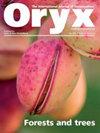尼泊尔东部低地贾塔尔森林中极度濒危的黄头陆龟Indotestudo elongata面临的威胁
IF 2.1
3区 环境科学与生态学
Q2 BIODIVERSITY CONSERVATION
引用次数: 0
摘要
贾塔尔森林(62.6平方公里)是尼泊尔东部低地曾经连续、郁郁葱葱、茂密的萨尔·肖拉·罗布斯塔和混合落叶植被地区的残余森林,现在被密集的人口所包围。这片森林是濒临绝种的黄头龟(Indotestudo elongata)最后的适宜栖息地之一。本研究于2021年9月至11月期间,通过对20个社区森林的实地调查和对22个社区森林用户群体和当地居民的80名成员的结构化访谈,探讨了Jalthal森林黄头龟的分布和面临的保护威胁。在11.3 km2的调查范围内,只发现了4株,种群密度为0.35株/km2。当地人认为物种减少的主要原因是狩猎(42%)和入侵物种入侵导致的栖息地恶化(30%)。根据对参与狩猎的当地人的采访,2017-2021年期间,每年平均有6.8只陆龟被杀死。狩猎的目的是Meche和Sathar社区的消费(70%)和民族医药用途(30%)。为了在贾塔尔森林中保护这一物种,需要在所有利益相关者之间开展宣传活动和沟通网络。本文章由计算机程序翻译,如有差异,请以英文原文为准。
Threats to the Critically Endangered yellow-headed tortoise Indotestudo elongata in Jalthal Forest, eastern lowland Nepal
Jalthal Forest (62.6 km2 ) is a remnant forest patch of a once continuous, lush and dense area of sal Shorea robusta and mixed deciduous vegetation in eastern lowland Nepal that is now surrounded by a dense human population. The forest is one of the last remnants of suitable habitat for the Critically Endangered yellow-headed tortoise Indotestudo elongata . This study explored the distribution of and conservation threats facing the yellow-headed tortoise in Jalthal Forest through field surveys in 20 community forests and structured interviews with 80 members of 22 community forest user groups and local people during September–November 2021. We surveyed 11.3 km2 of the forest and observed only four individuals of I. elongata , indicating a population density of 0.35/km2 . Local people perceived that the species is decreasing mainly because of hunting (42%) and habitat deterioration from incursion of invasive species (30%). Based on the interviews with local people involved in hunting, an annual mean of 6.8 tortoises were killed during 2017–2021. The purposes of hunting were consumption (70%) and ethnomedicinal uses (30%) by the Meche and Sathar communities. Awareness campaigns and networks of communication amongst all stakeholders are required to conserve this species in Jalthal Forest.
求助全文
通过发布文献求助,成功后即可免费获取论文全文。
去求助
来源期刊

Oryx
环境科学-生态学
CiteScore
5.30
自引率
7.40%
发文量
150
审稿时长
18-36 weeks
期刊介绍:
ORYX—THE INTERNATIONAL JOURNAL OF CONSERVATION, a quarterly journal from Fauna & Flora International, publishes research on biodiversity conservation, conservation policy and sustainable use, and the interactions of these matters with social, economic and political issues. The journal has a particular interest in material with the potential to improve conservation management and practice. Explore the map for details of published articles.
 求助内容:
求助内容: 应助结果提醒方式:
应助结果提醒方式:


